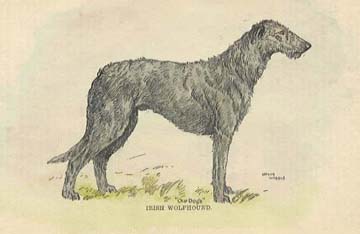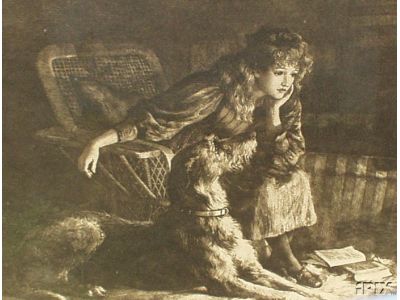Irish Wolfhounds
"Patience" by Herbert Dicksee
"The Viking's Daughter" by Herbert Dicksee
Tallest of dog breeds, noble of demeanor, steadfast of bearing, fabled in centuries of lore as the symbol of Celtic splendor.
I had long thought that some day, when I was a real grown up and had gone to live full-time in Ireland, I would have a cottage and several of these wonderful dogs around me. And then one day I just couldn't wait any longer. I had an “If not now, when?” moment and I decided that it was time for me to make the dream happen.
So I began to study the breed, and learned that in the Icelandic Saga of Burnt Njal, originally told approximately 1,000 years ago, a wolfhound is given as a gift -- with these words:
"I will give to thee . . . a hound that was given me in Ireland; he is big, and no worse follower than a sturdy man. Besides, it is part of his nature that he has man's wit, and he will bay at every man whom he knows is thy foe, but never at thy friends; he can see, too, in any man's face, whether he means thee well or ill, and he will lay down his life to be true to thee . . ."
I am fortunate indeed to live with them by my side.
1912 engraving of an Irish Wolfhound
They are the largest of the SightHounds, and use their keen eyesight and remarkable swift loping run to pursue their prey. For centuries they were used to hunt the biggest game, the giant Irish elk, and of course dire wolves. Both of which are now extinct... they did their job well! The breed standard says that they must be “capable of chasing down a wolf, and dispatching it.” Standing on back legs they are as tall as a human, they can put their paws on a human’s shoulders and look eye to eye.
Professor Grover Krantz so loved his Irish Wolfhounds that his last wish was to donate his body and theirs to science.
Their skeletons now reside together forever at the Smithsonian, a testament to enduring devotion.
They were kept in the hunting packs at castles, and also were fitted with armor and used in battle. They were trained to unhorse a knight by grabbing his leg and yanking him from his mount. Their other use was as the guardians of bards, who spent their lives walking from castle to castle, bringing entertainment and information throughout the countryside. Walking with wolfhounds meant the dogs could fend off wolves or brigands, and could hunt dinner. In fact the first dogs brought to the New World, by Christopher Columbus’s brother, were wolfhound crosses, able to track fleeing natives into the jungles.
"Silent Sympathy" by Herbert Dicksee
They have a special bond of empathy with their owners, and for many people, and I count myself one, having once shared my life and home with an Irish Wolfhound there is no other dog for me.
An Irish 6 pence coin
In my civilized life my hounds serve as the security force and escorts. They are my personal trainers, always up for a walk or a chance to investigate somewhere we've never been yet. Like all of their breed, they are gentle when stroked, fierce when provoked. So their companionship allows me to travel in confidence down any road, just as their ancestors protected their owners while traveling the byways of ancient Ireland. They are the ultimate companion animal, not a child substitute, a being of power and grace who has agreed to a life of service.
reclining wolfhound by Lucy Dawson
Walking with them I can companionably rest my hand on their backs as we go. Nice to not have to bend over to pet them! Appearing with them in public is to run a gauntlet of comments about them being as big as horses, asking about where their saddles are, you get the idea. Most people may have seen an Irish Wolfhound on TV competing at a dog show, or under the feast hall table in a film of life in ancient times, but to meet them in person is something else entirely. Their size being more like that of a human gives them a presence beyond what is usually accorded a dog. I confess that as I walk and answer the “What is THAT?” question I alternate between saying the true breed and announcing “They are Baskervilles.” Even though in almost all film versions of the Sherlock Holmes tale the “Hound of the Baskervilles” is portrayed by a Great Dane, the name seems a satisfying reply.
The Irish Wolfhound in these photos stands in the Irish National Museum of Natural History in Dublin. It was taxidermied 100 years ago, and gives us a marvelous chance to see what the breed looked like at that time, as it was being revived by Captain Graham and other breeders. Having almost gone extinct, the breed was rebuilt from the few remaining individuals and by bringing in other breeds. The signage in the case said that they were not yet satisfied with where the breed was, that they wanted more facial "furnishings" and denser bone, and greater size. Knowing the modern dog we can see that the persistence was successful, giving us the hound we know and love today. My life would not be complete without mine.
To see photos of my own Irish Wolfhounds click HERE.












